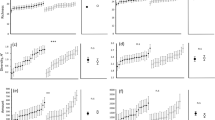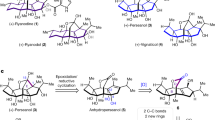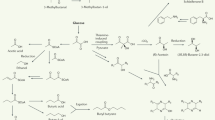Abstract
As the largest class of natural products, terpenes have a variety of roles in mediating antagonistic and beneficial interactions among organisms. They defend many species of plants, animals and microorganisms against predators, pathogens and competitors, and they are involved in conveying messages to conspecifics and mutualists regarding the presence of food, mates and enemies. Despite the diversity of terpenes known, it is striking how phylogenetically distant organisms have come to use similar structures for common purposes. New natural roles undoubtedly remain to be discovered for this large class of compounds, given that such a small percentage of terpenes has been investigated so far.
This is a preview of subscription content, access via your institution
Access options
Subscribe to this journal
Receive 12 print issues and online access
$259.00 per year
only $21.58 per issue
Buy this article
- Purchase on Springer Link
- Instant access to full article PDF
Prices may be subject to local taxes which are calculated during checkout




Similar content being viewed by others
References
Buckingham, J. (ed.) Dictionary of Natural Products (Chapman and Hall, London, 1994).
Langenheim, J.H. Higher plant terpenoids: a phytocentric overview of their ecological roles. J. Chem. Ecol. 20, 1223–1280 (1994).
Jansen, B.J.M. & de Groot, A. Occurrence, biological activity and synthesis of drimane sesquiterpenoids. Nat. Prod. Rep. 21, 449–477 (2004).
Rastogi, N. et al. Antimycobacterial activity of chemically defined natural substances from the Caribbean flora in Guadeloupe. FEMS Immunol. Med. Microbiol. 20, 267–273 (1998).
Lunde, C.S. & Kubo, I. Effect of polygodial on the mitochondrial ATPase of Saccharomyces cerevisiae. Antimicrob. Agents Chemother. 44, 1943–1953 (2000).
Justicia, J. et al. Total synthesis of 3-hydroxydrimanes mediated by titanocene(III)- evaluation of their antifeedant activity. Eur. J. Org. Chem. 2005, 712–718 (2005).
Lorimer, S.D., Perry, N.B., Foster, L.M. & Burgess, E.J. A nematode larval motility inhibition assay for screening plant extracts and natural products. J. Agric. Food Chem. 44, 2842–2845 (1996).
Ito, H., Muranaka, T., Mori, K., Jin, Z.X. & Yoshida, T. Dryofragin and aspidin PB, piscicidal components from Dryopteris fragrans. Chem. Pharm. Bull. (Tokyo) 45, 1720–1722 (1997).
Messchendorp, L., Gols, G.J.Z. & van Loon, J.J.A. Behavioural observations of Pieris brassicae larvae indicate multiple mechanisms of action of analogous drimane antifeedants. Entomol. Exp. Appl. 95, 217–227 (2000).
Paul, V.J. et al. Sesquiterpenoids of the drimane class from a sponge of the genus Dysidea. J. Nat. Prod. 60, 1115–1120 (1997).
Lee, S., Peterson, C.J. & Coats, J.R. Fumigation toxicity of monoterpenoids to several stored product insects. J. Stored Prod. Res. 39, 77–85 (2003).
Hammer, K.A., Carson, C.F. & Riley, T.V. Antifungal activity of the components of Melaleuca alternifolia (tea tree) oil. J. Appl. Microbiol. 95, 853–860 (2003).
Friedman, M., Henika, P.R. & Mandrell, R.E. Bactericidal activities of plant essential oils and some of their isolated constituents against Campylobacter jejuni, Escherichia coli, Listeria monocytogenes, and Salmonella enterica. J. Food Prot. 65, 1545–1560 (2002).
Frank, T., Bieri, K. & Speiser, B. Feeding deterrent effect of carvone, a compound from caraway seeds, on the slug Arion lusitanicus. Ann. Appl. Biol. 141, 93–100 (2002).
Szczepanik, M., Dams, I. & Wawrzeñczyk, C. Feeding deterrent activity of terpenoid lactones with the p-menthane system against the Colorado potato beetle (Coleoptera: Chrysomelidae). Environ. Entomol. 34, 1433–1440 (2005).
Vourc'h, G. et al. Monoterpene effect on feeding choice by deer. J. Chem. Ecol. 28, 2411–2427 (2002).
Dussourd, D.E. & Hoyle, A.M. Poisoned plusiines: toxicity of milkweed latex and cardenolides to some generalist caterpillars. Chemoecology 10, 11–16 (2000).
Aharoni, A. et al. Terpenoid metabolism in wild-type and transgenic Arabidopsis plants. Plant Cell 15, 2866–2884 (2003).
Chen, F. et al. Biosynthesis and emission of terpenoid volatiles from Arabidopsis flowers. Plant Cell 15, 481–494 (2003).
Erbilgin, N., Krokene, P., Christiansen, E., Zeneli, G. & Gershenzon, J. Exogenous application of methyl jasmonate elicits defenses in Norway spruce (Picea abies) and reduces host colonization by the bark beetle Ips typographus. Oecologia 148, 426–436 (2006).
Morrissey, J.P. & Osbourn, A.E. Fungal resistance to plant antibiotics as a mechanism of pathogenesis. Microbiol. Mol. Biol. Rev. 63, 708–724 (1999).
Papadopoulou, K., Melton, R.E., Leggett, M., Daniels, M.J. & Osbourn, A.E. Compromised disease resistance in saponin-deficient plants. Proc. Natl. Acad. Sci. USA 96, 12923–12928 (1999).
Laurent, P., Braekman, J.-C., Daloze, D. & Pasteels, J. Biosynthesis of defensive compounds from beetles and ants. Eur. J. Org. Chem. 2003, 2733–2743 (2003).
Quintana, A. et al. Interspecific variation in terpenoid composition of defensive secretions of European Reticulitermes termites. J. Chem. Ecol. 29, 639–652 (2003).
Nishida, R. Sequestration of defensive substances from plants by Lepidoptera. Annu. Rev. Entomol. 47, 57–92 (2002).
Carita, L., Mappes, J., Jussi, P. & Martti, V. Effects of group size and pine defence chemicals on Diprionid sawfly survival against ant predation. Oecologia 150, 519–526 (2006).
Burse, A. et al. Iridoid biosynthesis in Chrysomelina larvae: fat body produces early terpenoid precursors. Insect Biochem. Mol. Biol. 37, 255–265 (2007).
Paul, V.J., Puglisi, M.P. & Ritson-Williams, R. Marine chemical ecology. Nat. Prod. Rep. 23, 153–180 (2006).
Erickson, A.A., Paul, V.J., van Alstyne, K.L. & Kwiatkowski, L.M. Palatability of macroalgae that use different types of chemical defenses. J. Chem. Ecol. 32, 1883–1895 (2006).
Paul, V.J. & van Alstyne, K.L. Activation of chemical defenses in the tropical green algae Halimeda, spp. J. Exp. Mar. Biol. Ecol. 160, 191–203 (1992).
Jung, V. & Pohnert, G. Rapid wound-activated transformation of the green algal defensive metabolite caulerpenyne. Tetrahedron 57, 7169–7172 (2001).
Gavagnin, M. & Fontana, A. Diterpenes from marine opisthobranch molluscs. Curr. Org. Chem. 4, 1201–1248 (2000).
Bhadury, P. & Wright, P.C. Exploitation of marine algae: biogenic compounds for potential antifouling applications. Planta 219, 561–578 (2004).
Hedin, P.A., Parrott, W.L. & Jenkins, J.N. Relationships of glands, cotton square terpenoid aldehydes, and other allelochemicals to larval growth of Heliothis virescens (Lepidoptera, Noctuidae). J. Econ. Entomol. 85, 359–364 (1992).
Stipanovic, R.D., Bell, A.A. & Benedict, C.R. in Biologically Active Natural Products: Agrochemicals (eds. Culter, H.G. & Culter, S.J.) 211–220 (CRC Press, Boca Raton, Florida, USA, 1999).
Stipanovic, R.D., Puckhaber, L.S., Bell, A.A., Percival, A.E. & Jacobs, J. Occurrence of (+)- and (−)-gossypol in wild species of cotton and in Gossypium hirsutum Var. marie-galante (Watt) Hutchinson. J. Agric. Food Chem. 53, 6266–6271 (2005).
Liu, S. et al. The (−) enantiomer of gossypol possesses higher anticancer potency than racemic gossypol in human breast cancer. Anticancer Res. 22, 33–38 (2002).
Gonzalez-Garza, M.T., Matlin, S.A., Mata-Cardenas, B.D. & Said-Fernandez, S. Further studies on the in vitro activity of gossypol as antiamebic agent. Arch. Med. Res. 23, 69–70 (1992).
Matlin, S.A. et al. (−)-Gossypol: an active male antifertility agent. Contraception 31, 141–149 (1985).
Oliver, C.L. et al. (−)-Gossypol acts directly on the mitochondria to overcome Bcl-2- and Bcl-XL-mediated apoptosis resistance. Mol. Cancer Ther. 4, 23–31 (2005).
Wolter, K.G. et al. (−)-Gossypol inhibits growth and promotes apoptosis of human head and neck squamous cell carcinoma in vivo. Neoplasia 8, 163–172 (2006).
Stipanovic, R.D., Lopez, J.D., Jr., Dowd, M.K., Puckhaber, L.S. & Duke, S.E. Effect of racemic and (+)- and (−)-gossypol on the survival and development of Helicoverpa zea larvae. J. Chem. Ecol. 32, 959–968 (2006).
Puckhaber, L.S., Dowd, M.K., Stipanovic, R.D. & Howell, C.R. Toxicity of (+)- and (−)-gossypol to the plant pathogen, Rhizoctonia solani. J. Agric. Food Chem. 50, 7017–7021 (2002).
Sunilkumar, G., Campbell, L.M., Puckhaber, L., Stipanovic, R.D. & Rathore, K.S. Engineering cottonseed for use in human nutrition by tissue-specific reduction of toxic gossypol. Proc. Natl. Acad. Sci. USA 103, 18054–18059 (2006).
Soderlund, D.M. in Pyrethrum Flowers: Production, Chemistry, Toxicology, and Uses (eds. Casida, J.E. & Quistad, G.B.) 297–233 (Oxford University Press, New York, 1995).
Cox, S.D. et al. The mode of antimicrobial action of the essential oil of Melaleuca alternifolia (tea tree oil). J. Appl. Microbiol. 88, 170–175 (2000).
Inoue, Y. et al. The antibacterial effects of terpene alcohols on Staphylococcus aureus and their mode of action. FEMS Microbiol. Lett. 237, 325–331 (2004).
Guillet, G., Bélanger, A. & Arnason, J.T. Volatile monoterpenes in Porophyllum gracile and P. ruderale (Asteraceae): identification, localization and insecticidal synergism with α-terthienyl. Phytochemistry 49, 423–429 (1998).
Kang, R. et al. Antimicrobial activity of the volatile constituents of Perilla frutescens and its synergistic effects with polygodial. J. Agric. Food Chem. 40, 2328–2330 (1992).
Kanikkannan, N., Kandimalla, K., Lamba, S.S. & Singh, M. Structure-activity relationship of chemical penetration enhancers in transdermal drug delivery. Curr. Med. Chem. 7, 593–608 (2000).
Krishna, S., Woodrow, C.J., Staines, H.M., Haynes, R.K. & Mercereau-Puijalon, O. Re-evaluation of how artemisinins work in light of emerging evidence of in vitro resistance. Trends Mol. Med. 12, 200–205 (2006).
Eckstein-Ludwig, U. et al. Artemisinins target the SERCA of Plasmodium falciparum. Nature 424, 957–961 (2003).
Jordan, M.A. & Wilson, L. Microtubules as a target for anticancer drugs. Nat. Rev. Cancer 4, 253–265 (2004).
Dudareva, N., Negre, F., Nagegowda, D.A. & Orlova, I. Plant volatiles: recent advances and future perspectives. Crit. Rev. Plant Sci. 25, 417–440 (2006).
Francke, W. & Dettner, K. in Chemistry of Pheromones and Other Semiochemicals II (ed. Schulz, S.) 85–166 (Springer-Verlag, Berlin, 2005).
Hick, A.J., Luszniak, M.C. & Pickett, J.A. Volatile isoprenoids that control insect behaviour and development. Nat. Prod. Rep. 16, 39–54 (1999).
Hardie, J., Pickett, J.A., Pow, E.M. & Smiley, D.W.M. in Pheromones of Non-Lepidopteran Insects Associated with Agricultural Plants (eds Hardie, J. & Minks, A.K.) 227–250 (CAB International, Wallingford, UK, 1999).
Kunert, G., Otto, S., Röse, U.S.R., Gershenzon, J. & Weisser, W.W. Alarm pheromone mediates production of winged dispersal morphs in aphids. Ecol. Lett. 8, 596–603 (2005).
Beale, M.H. et al. Aphid alarm pheromone produced by transgenic plants affects aphid and parasitoid behavior. Proc. Natl. Acad. Sci. USA 103, 10509–10513 (2006).
Gibson, R.W. & Pickett, J.A. Wild potato repels aphids by release of aphid alarm pheromone. Nature 302, 608–609 (1983).
Knudsen, J.T., Eriksson, R., Gershenzon, J. & Stahl, B. Diversity and distribution of floral scent. Bot. Rev. 72, 1–120 (2006).
Wright, G.A., Lutmerding, A., Dudareva, N. & Smith, B.H. Intensity and the ratios of compounds in the scent of snapdragon flowers affect scent discrimination by honeybees (Apis mellifera). J. Comp. Physiol. [A] 191, 105–114 (2005).
Raguso, R.A. & Light, D.M. Electroantennogram responses of male Sphinx perelegans hawkmoths to floral and “green-leaf volatiles”. Entomol. Exp. Appl. 86, 287–293 (1998).
Shields, V.D.C. & Hildebrand, J.G. Responses of a population of antennal olfactory receptor cells in the female moth Manduca sexta to plant-associated volatile organic compounds. J. Comp. Physiol. [A] 186, 1135–1151 (2001).
Hansson, B.S., Carlsson, M.A. & Kalinovà, B. Olfactory activation patterns in the antennal lobe of the sphinx moth, Manduca sexta. J. Comp. Physiol. [A] 189, 301–308 (2003).
Carlsson, M.A., Galizia, C.G. & Hansson, B.S. Spatial representation of odours in the antennal lobe of the moth Spodoptera littoralis (Lepidoptera: Noctuidae). Chem. Senses 27, 231–244 (2002).
Carlsson, M.A. & Hansson, B.S. in Biology of Floral Scent (eds. Dudareva, N. & Pichersky, E.) 243–261 (Taylor & Francis, Boca Raton, Florida, USA, 2006).
Dicke, M. et al. Isolation and identification of volatile kairomone that affects acarine predator-prey interactions- involvement of host plant in its production. J. Chem. Ecol. 16, 381–396 (1990).
Turlings, T.C.J., Tumlinson, J.H. & Lewis, W.J. Exploitation of herbivore-induced plant odors by host-seeking parasitic wasps. Science 250, 1251–1253 (1990).
Kessler, A. & Baldwin, I.T. Defensive function of herbivore-induced plant volatile emissions in nature. Science 291, 2141–2144 (2001).
Kappers, I.F. et al. Genetic engineering of terpenoid metabolism attracts bodyguards to Arabidopsis. Science 309, 2070–2072 (2005).
Schnee, C. et al. The products of a single maize sesquiterpene synthase form a volatile defense signal that attracts natural enemies of maize herbivores. Proc. Natl. Acad. Sci. USA 103, 1129–1134 (2006).
Hilker, M., Kobs, C., Varama, M. & Schrank, K. Insect egg deposition induces Pinus sylvestris to attract egg parasitoids. J. Exp. Biol. 205, 455–461 (2002).
Mumm, R. & Hilker, M. The significance of background odour for an egg parasitoid to detect plants with host eggs. Chem. Senses 30, 337–343 (2005).
Mumm, R., Schrank, K., Wegener, R., Schulz, S. & Hilker, M. Chemical analysis of volatiles emitted by Pinus sylvestris after induction by insect oviposition. J. Chem. Ecol. 29, 1235–1252 (2003).
Rasmann, S. et al. Recruitment of entomopathogenic nematodes by insect-damaged maize roots. Nature 434, 732–737 (2005).
Matusova, R. et al. The strigolactone germination stimulants of the plant-parasitic Striga and Orobanche spp. are derived from the carotenoid pathway. Plant Physiol. 139, 920–934 (2005).
Akiyama, K., Matsuzaki, K. & Hayashi, H. Plant sesquiterpenes induce hyphal branching in arbuscular mycorrhizal fungi. Nature 435, 824–827 (2005).
Carroll, M.J., Schmelz, E.A., Meagher, R.L. & Teal, P.E.A. Attraction of Spodoptera frugiperda larvae to volatiles from herbivore-damaged maize seedlings. J. Chem. Ecol. 32, 1911–1924 (2006).
Runyon, J.B., Mescher, M.C. & De Moraes, C.M. Volatile chemical cues guide host location and host selection by parasitic plants. Science 313, 1964–1967 (2006).
Bouwmeester, H.J., Matusova, R., Zhongkui, S. & Beale, M.H. Secondary metabolite signaling in host-parasitic plant interactions. Curr. Opin. Plant Biol. 6, 358–364 (2003).
Heil, M. & Bueno, J.C.S. Within-plant signalling by volatiles leads to induction and priming of an indirect plant defense in nature. Proc. Natl. Acad. Sci. USA 104, 5467–5472 (2007).
Baldwin, I.T., Halitschke, R., Paschold, A., von Dahl, C.C. & Preston, C.A. Volatile signaling in plant-plant interactions: 'talking trees' in the genomic era. Science 311, 812–815 (2006).
Dicke, M. & Bruin, J. Chemical information transfer between plants: back to the future. Biochem. Syst. Ecol. 29, 981–994 (2001).
Ton, J. et al. Priming by airborne signals boosts direct and indirect resistance in maize. Plant J. 49, 16–26 (2007).
Pimentel, D. & Bellotti, A.C. Parasite-host population systems and genetic stability. Am. Nat. 110, 877–888 (1976).
Zhao, J.-Z. et al. Transgenic plants expressing two Bacillus thuringiensis toxins delay insect resistance evolution. Nat. Biotechnol. 21, 1493–1497 (2003).
Feeny, P. in Herbivores: Their Interactions with Secondary Plant Metabolites 2nd edn, Vol. 2 (eds. Rosenthal, G.A. & Berenbaum, M.R.) 1–44 (Academic Press, San Diego, 1992).
Fewell, A.M. & Roddick, J.G. Interactive antifungal activity of the glycoalkaloids α-solanine and α-chaconine. Phytochemistry 33, 323–328 (1993).
Stermitz, F.R., Lorenz, P., Tawara, J.N., Zenewicz, L.A. & Lewis, K. Synergy in a medicinal plant: antimicrobial action of berberine potentiated by 5′-methoxyhydnocarpin, a multidrug pump inhibitor. Proc. Natl. Acad. Sci. USA 97, 1433–1437 (2000).
Berenbaum, M. & Neal, J.J. Synergism between myristicin and xanthotoxin, a naturally co-occurring plant toxicant. J. Chem. Ecol. 11, 1349–1358 (1985).
Akhtar, Y. & Isman, M.B. Binary mixtures of feeding deterrents mitigate the decrease in feeding deterrent response to antifeedants following prolonged exposure in the cabbage looper, Trichoplusia ni (Lepidoptera: Noctuidae). Chemoecology 13, 177–182 (2003).
Phillips, M.A. & Croteau, R.B. Resin-based defenses in conifers. Trends Plant Sci. 4, 184–190 (1999).
Himejima, M., Hobson, K.R., Otsuka, T., Wood, D.L. & Kubo, I. Antimicrobial terpenes from oleoresin of ponderosa pine tree Pinus ponderosa: a defense mechanism against microbial invasion. J. Chem. Ecol. 18, 1809–1818 (1992).
Challis, G.L. & Hopwood, D.A. Synergy and contingency as driving forces for the evolution of multiple secondary metabolite production by Streptomyces species. Proc. Natl. Acad. Sci. USA 100, 14555–14561 (2003).
Staerk, D. et al. Isolation of a library of aromadendranes from Landophia dulcis and its characterization using the VolSurf approach. J. Nat. Prod. 67, 799–805 (2004).
Firn, R.D. & Jones, C.G. Natural products– a simple model to explain chemical diversity. Nat. Prod. Rep. 20, 382–391 (2003).
Ridley, R.G. Malaria: to kill a parasite. Nature 424, 887–889 (2003).
Acknowledgements
The authors are grateful to K. Falk for help with references and figures, and to the Max Planck Society (J.G.), the German National Science Foundation (J.G.), the European Commission (J.G.), and the US National Science Foundation (N.D.) for supporting their research on terpenes.
Author information
Authors and Affiliations
Corresponding author
Ethics declarations
Competing interests
The authors declare no competing financial interests.
Rights and permissions
About this article
Cite this article
Gershenzon, J., Dudareva, N. The function of terpene natural products in the natural world. Nat Chem Biol 3, 408–414 (2007). https://doi.org/10.1038/nchembio.2007.5
Published:
Issue Date:
DOI: https://doi.org/10.1038/nchembio.2007.5
This article is cited by
-
Short- and long-term effects of essential oils on swine spermatozoa during liquid phase refrigeration
Scientific Reports (2024)
-
Integrative metabolome and transcriptome analyses reveal the differences in flavonoid and terpenoid synthesis between Glycyrrhiza uralensis (licorice) leaves and roots
Food Science and Biotechnology (2024)
-
Aromatase inhibition using Juniperus procera phytochemical constituents: molecular docking study
Journal of Umm Al-Qura University for Applied Sciences (2024)
-
Factors that influence the extraction methods of terpenes from natural sources
Chemical Papers (2024)
-
A quantitative method to measure geranylgeranyl diphosphate (GGPP) and geranylgeranyl monophosphate (GGP) in tomato (Solanum lycopersicum) fruit
Plant Methods (2023)



